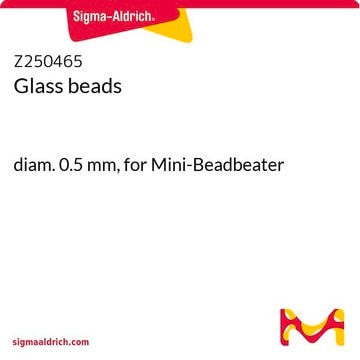18406
Glass beads
diam. ~5 mm
Synonym(s):
Glass beads, Anti-bumping granules
Sign Into View Organizational & Contract Pricing
All Photos(1)
About This Item
UNSPSC Code:
12352103
NACRES:
NA.22
Recommended Products
diam.
~5 mm
Quality Level
Looking for similar products? Visit Product Comparison Guide
Related Categories
General description
Glass beads ~5 mm are made of high purity soda-lime glass.
Application
Glass beads are generally added to the boiling solutions to prevent bumping. It is also used as supports to various photocatalysts to enhance the adsorption of organic pollutants in photocatalysis.
Storage Class Code
11 - Combustible Solids
WGK
nwg
Flash Point(F)
Not applicable
Flash Point(C)
Not applicable
Personal Protective Equipment
dust mask type N95 (US), Eyeshields, Gloves
Choose from one of the most recent versions:
Already Own This Product?
Find documentation for the products that you have recently purchased in the Document Library.
Customers Also Viewed
Effect of adsorbents coated with titanium dioxide on the photocatalytic degradation of propoxur.
Lu MC, et al.
Chemosphere, 38(3), 617-627 (1999)
The polyhydric alcohol-polybasic acid reaction. I. Glycerol-phthalic anhydride.
Kienle RH and Hovey AG
Journal of the American Chemical Society, 51(2), 509-519 (1929)
Lisheng Ni et al.
Nucleic acids research, 37(20), 6970-6983 (2009-09-18)
Plasmids harbored by Staphylococcus aureus are a major contributor to the spread of bacterial multi-drug resistance. Plasmid conjugation and partition are critical to the dissemination and inheritance of such plasmids. Here, we demonstrate that the ArtA protein encoded by the
Jackie K Cheung et al.
PloS one, 4(6), e5849-e5849 (2009-06-11)
Toxin production in Clostridium perfringens is controlled by the VirSR two-component signal transduction system, which comprises the VirS sensor histidine kinase and the VirR response regulator. Other studies have concentrated on the elucidation of the genes controlled by this network;
Lise-Andree Gobeil et al.
Frontiers in bioscience : a journal and virtual library, 13, 2203-2215 (2007-11-06)
The ribonuclease III Dicer (Dcr1) has been shown to be required for chromosome segregation and gene silencing in Schizosaccharomyces pombe. These effects are thought to be transcriptional, mediated by formation and maintenance of heterochromatin, and guided by small RNAs derived
Our team of scientists has experience in all areas of research including Life Science, Material Science, Chemical Synthesis, Chromatography, Analytical and many others.
Contact Technical Service






